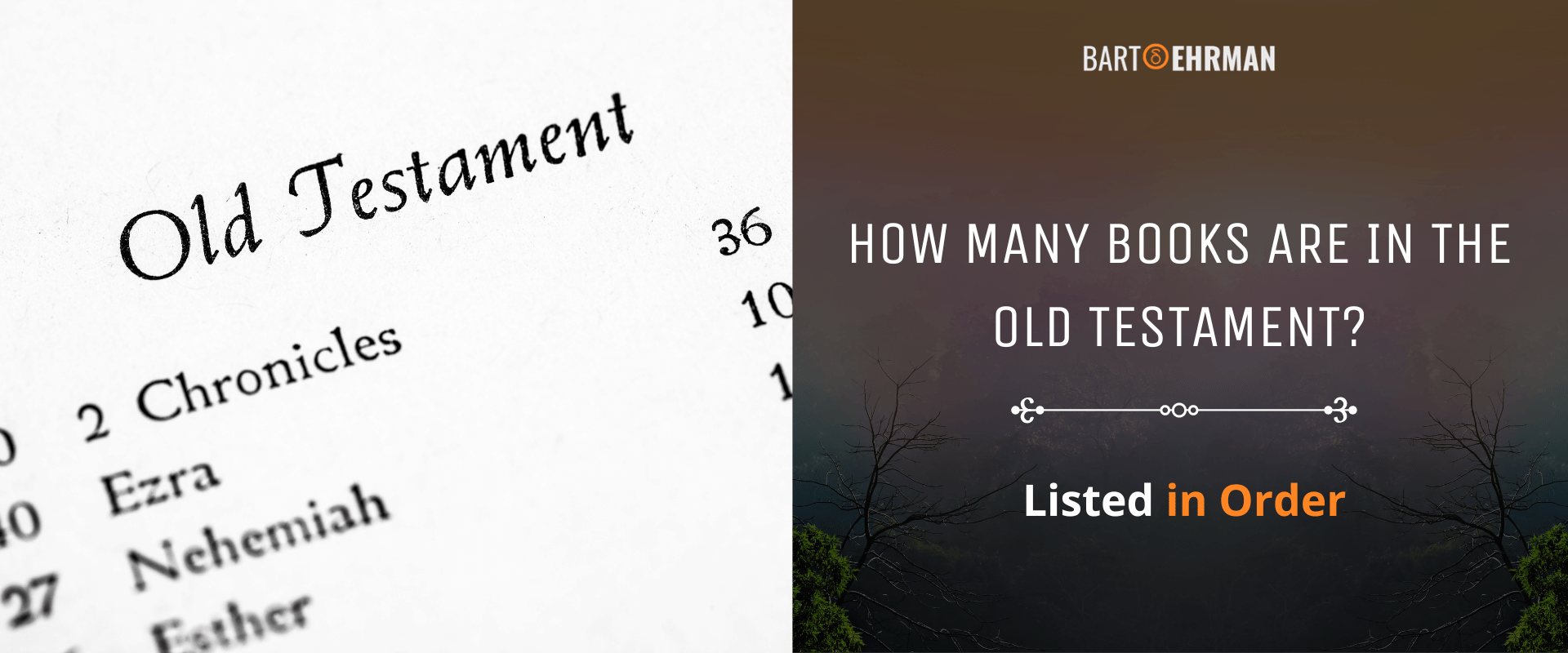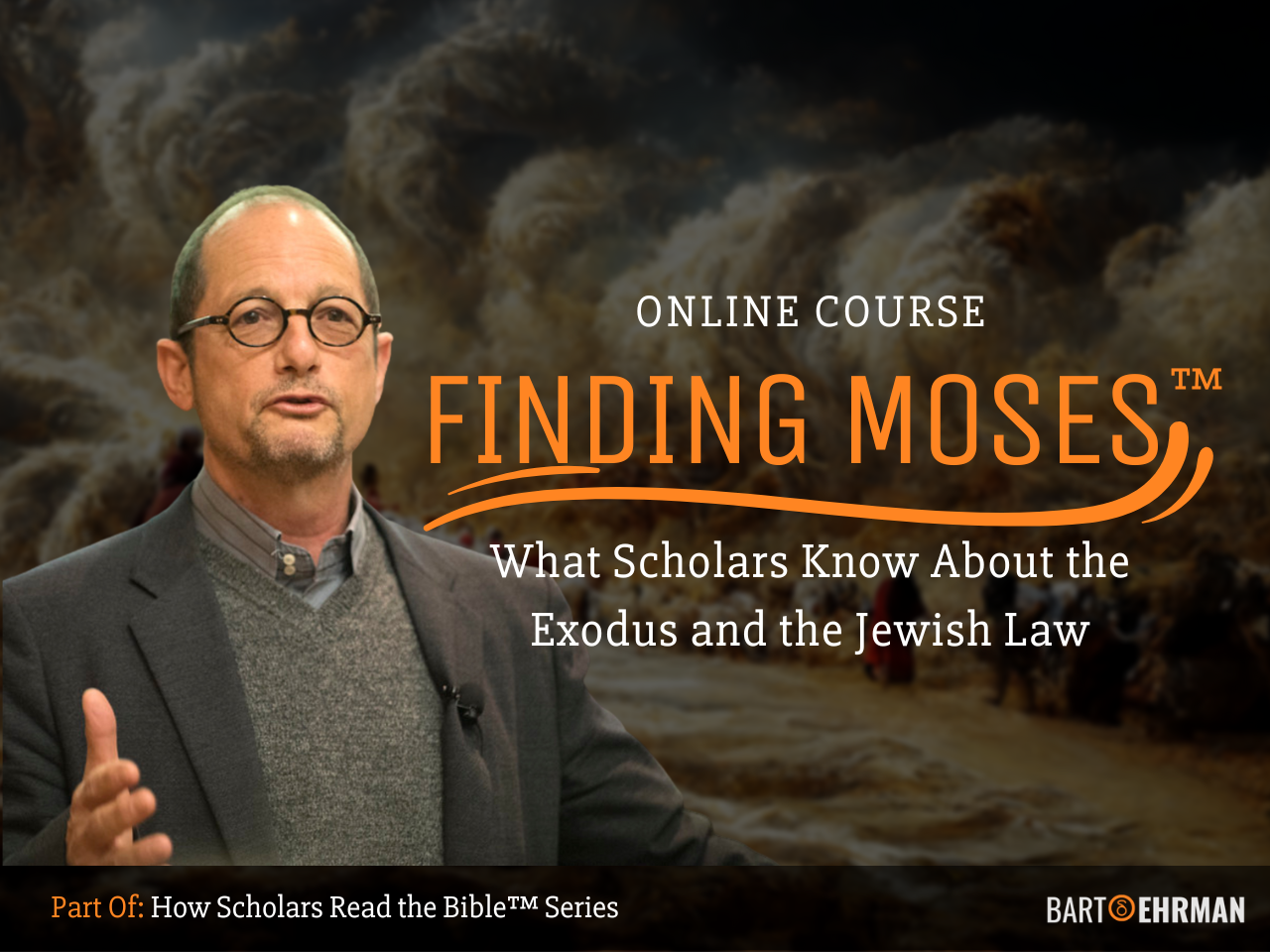How Many Books are in the Old Testament? (List in Order)

Written by Marko Marina, Ph.D.
Author | Historian | BE Contributor
Verified! See our guidelines
Verified! See our editorial guidelines
Date written: April 5th, 2024
Disclaimer: The views and opinions expressed in this article belong to the author and do not necessarily match my own. - Dr. Bart D. Ehrman
Christians and Jews share a collection of sacred writings central to their faiths. For Christians, this collection is known as the Old Testament, while Jews refer to it as the Tanakh or the Hebrew Bible. Composed in Hebrew, with parts in Aramaic, these texts were penned by ancient Israelites across many centuries.
The Old Testament encompasses many genres, including narrative tales, philosophical musings, poetry, historical accounts, and even mystic visions. These writings not only unveil the history of a remarkable people but have also laid the foundation for art, literature, law, and religious beliefs in Western culture up to the present day.
This leads us to the intriguing question: How many books are in the Old Testament? The answer isn’t as simple as one would think.
The shared heritage of these texts presents itself in varied forms across different religious traditions. The number of books included in the Old Testament can differ, reflecting the diverse ways in which communities have interacted with these texts throughout history.

In this article, we aim to delve into the structure of the Old Testament, exploring the number of books it contains and offering insights into their grouping. While we have provided summaries of each book in the Old Testament in an earlier article, here we’ll focus on highlighting some interesting aspects of specific books within the following categories:
Moreover, we’ll detail the list of the Old Testament books as grouped according to the mentioned categories.
Our goal is to present this information in a manner that is accessible and engaging to a wide audience, regardless of their prior knowledge or academic background. Join us as we embark on this journey through one of the cornerstones of religious literature.
List of the Old Testament Books (In Order)
Before we delve any further, it seems useful to make a list of Old Testament books. Scroll down to take a closer look at the structure and specific groupings of each Old Testament section in order.
- Genesis
- Exodus
- Leviticus
- Numbers
- Deuteronomy
- Joshua
- Judges
- Ruth
- 1 Samuel
- 2 Samuel
- 1 Kings
- 2 Kings
- 1 Chronicles
- 2 Chronicles
- Ezra
- Nehemiah
- Esther
- Job
- Psalms
- Proverbs
- Ecclesiastes
- Song of Solomon
- Isaiah
- Jeremiah
- Lamentations
- Ezekiel
- Daniel
- Hosea
- Joel
- Amos
- Obadiah
- Jonah
- Micah
- Nahum
- Habakkuk
- Zephaniah
- Haggai
- Zechariah
- Malachi
How Many Books Are in the Pentateuch?
Any answer to the “How many books are in the Old Testament?” question has to start with the five books in the Pentateuch.
The Pentateuch holds a place of paramount importance in Jewish religious tradition and is regarded as the most authoritative part of the Bible. While tradition attributes the authorship of these five books in order - Genesis, Exodus, Leviticus, Numbers, and Deuteronomy - to Moses, critical scholarship suggests a more complex process of composition over time.
The Book of Genesis, for instance, starts with the creation of the world and moves through the early stories of humanity, including the Fall. It predominantly narrates the lives of the patriarchs from Abraham to Joseph.
Unlike the other creation stories from the ancient Near East, Genesis begins without detailing the origins of God, Yahweh. This omission could be understood as a deliberate effort by the ancient Israelites to differentiate their beliefs from neighboring mythologies, emphasizing a unique theological perspective that God's origin is beyond human storytelling.
The Pentateuch | Description |
|---|---|
Genesis | One of the points of this text is that the world is not made up of mutually opposed forces, the sun and moon are not deities, and the sky is not full of divinities. The entire world comes from one God. |
Exodus | This book covers Israel's enslavement in Egypt, Moses' leadership, the plagues upon Egypt, and the dramatic exodus of the Israelites. It climaxes with the giving of the Law to Moses and the instructions for constructing a worship tent in the wilderness. |
Leviticus | Leviticus focuses on the laws given to the Israelites through Moses, particularly those concerning worship and sacrifice. Leviticus serves as a guide for maintaining holiness and purity in worship practices. |
Numbers | Recounting the 40-year journey of the Israelites in the wilderness under Moses' guidance, Numbers details the challenges, rebellions, and faithfulness of the people as they move towards the Promised Land. |
Deuteronomy | Comprising long discourses delivered by Moses, Deuteronomy urges the Israelites towards obedience as they stand on the threshold of Canaan. |
These books not only recount the formative stories of the Israelite people but also establish the theological and moral foundation of their covenant with God. Through these narratives and laws, the Pentateuch sets the stage for the rest of the Old Testament.
Following the foundational narratives and laws of the Pentateuch, the second major grouping in the Old Testament takes us through the historical journey of the Israelite people, tracing their trials and triumphs. This group of texts is usually designated as the Historical books. Let’s take a closer look!
How Many Books are in the Historical Section?
The Historical books of the Old Testament chronicle the narrative of the Israelite people from their entrance into the Promised Land (the land of Canaan) through the establishment and fall of their kingdom, to their exile and return.
How many books are in the Historical section? The answer isn’t as straightforward as it was with the previous category. The number of books varies among the Jewish, Protestant, Catholic, and Orthodox traditions:
Below, you’ll find a table listing the historical books in order, organized according to the different religious traditions.
Tradition | Historical Books |
|---|---|
Jewish | Integrated into Nevi’im: Joshua, Judges, 1 and 2 Samuel, and 1 and 2 Kings |
Protestant Christianity | Joshua, Judges, Ruth, 1 and 2 Samuel, 1 and 2 Kings, 1 and 2 Chronicles, Ezra, Nehemiah, Esther |
Catholic Christianity | All of the above, plus Tobit, Judith, 1 and 2 Maccabees |
Orthodox Christianity | All of the above, plus 3 Maccabees and 1 Esdras |
A brief look at the historical section has revealed varied compositions of the Old Testament across different religious traditions. This often leads to the intriguing question: What are the 46 books of the Old Testament?
In contrast to Protestants who accept 39 books of the Old Testament, the Catholic Church acknowledges 7 extra books thus making the total number 46. These writings are usually called “Deuterocanonical books” and were formally canonized at the Council of Trent between 1545 and 1563. The Deuterocanonical books include:
- Tobith
- Judith
- Wisdom of Solomon
- Sirach
- Baruch
- 1 Maccabees
- 2 Maccabees
In the mid-20th century, German scholar Martin Noth introduced the idea that the Old Testament books from Joshua to 2 Kings should be considered as one cohesive narrative. This sequence includes Joshua, Judges, both books of Samuel, and both books of Kings. Noth named this unified collection the Deuteronomistic History.
The initial volumes of the Deuteronomistic History, Joshua and Judges, offer differing perspectives on Israel's establishment in Canaan. Scholars and archaeologists have identified four distinct theories to explain these narratives:
Despite different theories and models, these books aren’t only essential for understanding the historical journey of the Israelite people but they also contain strong theological messages often pointing out the consequences of turning away from God.
Now that we’ve presented the section traditionally depicted as the “Historical books”, we can further explore how many books are in the Old Testament by looking at the third grouping of texts that delves into the realms of wisdom and poetry.
How Many Books are in the Wisdom and Poetic Section?
The Wisdom and Poetic books of the Old Testament are a collection of texts that dive deep into the themes of wisdom, ethics, the human condition, and the nature of God. Unlike the narrative and legal texts of earlier sections, these books are characterized by their poetic form and philosophical content.
This section includes several key works that have been influential not only within religious contexts but also in the broader fields of literature and philosophy. The books listed here in order are central to both Jewish and Christian traditions:
Wisdom and Poetic Books | Short Description |
|---|---|
Job | Explores suffering and justice. |
Psalms | Collection of hymns and prayers. |
Proverbs | Wise sayings and teachings on virtue. |
Ecclesiastes | Philosophical quest for life's meaning. |
Song of Solomon | Celebrates love and union through poetry. |
Among the books of wisdom and poetry, the Psalms stand out for their deep resonance with Christians, especially because Jesus quotes various verses from the Psalms in the Gospels. One of the most poignant examples is his cry from the cross, which is recorded in the Gospel of Mark: "My God, my God, why have you forsaken me?" (Psalm 22).
When examining a psalm, biblical scholars typically consider three critical questions:
These inquiries have been foundational since the early 20th century, notably through the work of German biblical scholar Hermann Gunkel. Gunkel's influence on Psalm studies is unparalleled, particularly with his analysis of psalms into specific genres (e.g., individual laments, communal thanksgivings) and the recognition that these genres follow distinct structural patterns.
Did You Know?
Isaiah 53 holds a place of prominence, frequently referenced by Christians as evidence that Jesus, as the Messiah, fulfilled Old Testament prophecies. Indeed, the verses: "But he was pierced for our transgressions, he was crushed for our iniquities; the punishment that brought us peace was on him, and by his wounds we are healed," strongly evoke images of Jesus' crucifixion for many readers.
However, biblical scholars have long recognized that the original interpretation of Isaiah 53 doesn’t align at all with the concept of a suffering Messiah. Interestingly, the traditional Jewish expectation of the Messiah did not encompass the idea of suffering and death. Instead, Jews consistently believed the Messiah would be the great and powerful figure who would deliver Israel from its oppressors.
When Jews heard early Christian proclamations of Jesus’ messianic identity, they were astounded. Probably as much as my Christian friends when I tell them that the original context of Isaiah 53 clearly describes the suffering of the servant as a past event and never uses the term “Messiah” at all.
The genre of thanksgiving psalms, for example, can be divided into four components. In the beginning, there is an expression of gratitude for God's deeds or attributes. This is followed by an account of past difficulties. The psalmist then tells how God helped him in his time of need. The psalm concludes with a renewed thanksgiving or a vow to praise God.
Psalm 18 serves as an exemplary model of this structure. It begins with a declaration of love: "I love you, Lord." Then, it describes a moment of peril: "Cords of death encompassed me; torrents of destruction terrified me."
The narrative moves to the psalmist's plea for divine intervention: “In my distress, I called out: 'Lord!' I cried out to my God. From his temple he heard my voice; my cry to him reached his ears." God's timely intervention is celebrated, leading to a closing note of praise: "The Lord lives! Blessed be my rock!”
While the Psalms hold a special place in the hearts of many Christians for their profound expressions of faith and distress, the next collection of Old Testament texts—the Prophetic writings - arguably exerted the greatest impact on the formation of early Christian theology.
These books, filled with prophecies, were seen by early Christians as foretelling the coming of Jesus, marking Him as the fulfillment of these ancient visions and deepening the connection between the Old and New Testaments.

How Many Books Are in the Prophets?
There are 17 books within the Prophetic section of the Old Testament. These texts are usually divided into two main groups: the Major Prophets and the Minor Prophets. This division isn't about their importance but rather the length of the texts. The Major Prophets include longer books that contain complex messages and visions, while the Minor Prophets consist of shorter texts with concise messages.
The Major Prophets are in order: Isaiah, Jeremiah, Lamentations (traditionally attributed to Jeremiah), Ezekiel, and Daniel.
The Minor Prophets include twelve books from Hosea to Malachi. They address the moral and spiritual lapses of the people and call them back to faithfulness towards God. The table below depicts the prophetic books of the Old Testament.
Major Prophets | Minor Prophets |
|---|---|
Isaiah | Hosea |
Of particular note is the Book of Jeremiah, where Jeremiah endures more persecution than any other prophet. He is ridiculed, nearly assassinated, and thrown into a water storage tank. While outwardly he appears steadfast, a closer examination of his thoughts reveals turmoil and self-doubt, leading him to even question his calling as a prophet.
The work of American biblical scholar Walter Brueggemann brings out two overarching themes in Jeremiah with the phrases "to pluck up and tear down" and "to build and to plant." The initial message speaks to destruction and uprooting, marking God's decision to deliver the Jews into the hands of Babylonians in 597 B.C.E. as a consequence of their prolonged defiance.
Conversely, Jeremiah also conveys a vital theme of construction and cultivation, embodying the concept of unending hope. Notably, chapters 30-32 feature the phrase "You will be my people and I will be your God" more frequently than anywhere else in the Old Testament - a formula signifying the covenant between God and His people.
This indicates a promised triumph after a period of hardship and subjugation. God assures them that despite the current exile and the daunting barriers to returning home, a time will come when they can go back. Essentially, God pledges that he intends to rebuild and replant.
Conclusion
How many books are in the Old Testament? As we have seen, the number varies: The Protestant Bible contains 39 books of the Old Testament, while Catholic Bibles include 46 due to the addition of seven Deuterocanonical books.
This article has journeyed through the structural organization of the Old Testament, providing insights into the Pentateuch, Historical Books, Wisdom and Poetic Books, and the Prophets. Each section has its distinct significance, offering a glimpse into the spiritual, moral, and cultural foundation of ancient Israelite society.
By exploring specific aspects of selected texts, we've highlighted the complexity and depth of these writings, which continue to influence religious thought, academic scholarship, and cultural practices today.
Finally, this article emphasized the importance of understanding these ancient texts within their historical and cultural contexts without imposing later ideas and theories that can distort their original meaning.

